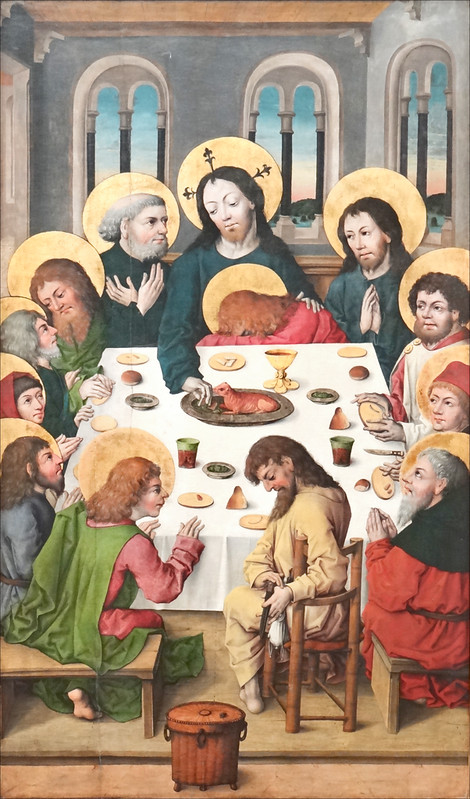Matthew 26. 14-16; 21-25
Then one of the twelve, who was called Judas Iscariot, went to the chief priests and said, ‘What will you give me if I betray him to you?’ They paid him thirty pieces of silver. And from that moment he began to look for an opportunity to betray him.
…while they were eating, [Jesus] said, ‘Truly I tell you, one of you will betray me.’ And they became greatly distressed and began to say to him one after another, ‘Surely not I, Lord?’ He answered, ‘The one who has dipped his hand into the bowl with me will betray me. The Son of Man goes as it is written of him, but woe to that one by whom the Son of Man is betrayed! It would have been better for that one not to have been born.’ Judas, who betrayed him, said, ‘Surely not I, Rabbi?’ He replied, ‘You have said so.’
A story
In a church, on Maundy Thursday in Holy Week, the altar was stripped, and the church laid bare. People were asked to stay and watch and pray. The lights were turned down and the church fell silent. The last act of the night was shocking: thirty silver coins were thrown sharply towards the altar, falling on the ground, clattering and rolling away across the stone floor….
The picture points to a part of the story of Jesus’s Passion that we often overlook. Judas Iscariot was the money man out of the disciples, trusted with the common purse, and he is the disciple who breaks the solidarity of the Last Supper, told by Jesus to go out and do what he has to do. He betrays Jesus to the authorities and is paid the thirty pieces of silver. We have seen it coming. When Mary anoints Jesus with perfume, Judas fails to recognise the significance of her actions, only the apparent extravagance. He is not on the same page. He seems to be expecting something else from Jesus’s words and actions, – a fight, not a willingness to go to death.
When do you think the breaking of the relationship, the fellowship actually occurs? Is it when ‘Satan enters into’ Judas? Is it when he actually goes out and sets up the betrayal? Is it when he kisses Jesus (often the subject of poignant and dramatic paintings of the scene)? Has the breaking of the relationship with Jesus and the disciples happened long before it, as Judas fails to understand Jesus’s mission and wants to make something else happen instead? Is the final break when Judas takes his own life or does the relationship continue in some way to endure?
A story
A vicar leading an assembly in a church primary school was talking about Easter and the Resurrection of Jesus. He asked the children who they thought Jesus would want to meet after he rose from the dead.
One child said that Jesus would most want to meet his friend Judas, because Jesus must have been so sad that Judas had died and so that Jesus and all his other friends would all be together again and no-one left behind.
Some of the new words of today’s social media sound deeply unpleasant: ‘cancelling’, ‘no-platforming’, ‘ghosting’, ‘gaslighting’, ‘unfriending’, ‘blocking’. All these words refer to breaking relationships, whether those are online or in-person. To be cancelled or ghosted is painful, a sense of being excluded, ‘sent to Coventry’, frozen out, or shunned. In some religious groups, even some churches, people have been treated like this for breaking the rules of the group, for speaking out about things like abuse, or because they are in receipt of a judgement by their community. In addition to the hurt and bewilderment many feel, such treatment is spiritually painful, leaving people in a dark, friendless place.
Many survivors of abuse within churches tell us about the pain of being treated like this, intentionally or unintentionally, after they have made a complaint or told their story. While all due safeguarding processes have to be followed, one of the problems is that they feel victimised all over again by the fact that the Church they rely on and need to support them spiritually ceases to be relational. Psychological and spiritual damage can percolate out from allegations of abuse, as others, who may not have been abused or witnessed anything to do with it, have to reconfigure their memories and experiences in the light of what is now known. People associated with Jean Vanier, for example, loved and revered by so many because of what he did for the L’Arche community, were deeply distressed to find out that he had another side, which had used his considerable power and influence to abuse others. https://en.wikipedia.org/wiki/Jean_Vanier
A nun, who formed friendships with people on death row was asked why she did this. She said it was because every human person is more than the worst thing they have done.
What might it mean for a Church based on friendship, and deep loving relationships to build on these foundations to help and support those who have been hurt, and to reach out to the perpetrators themselves?
Some ideas to ponder:
- What do you think about the child’s view of Jesus and Judas?
- How can relationships be rebuilt? What could we offer to those who have been physically, mentally and spiritually hurt by the actions of others?
- How might a commitment to relationality affect how we commit to safeguarding?
- How can we ‘uncancel’ people who have been excluded, frozen out or shunned by their Christian brothers and sisters?




